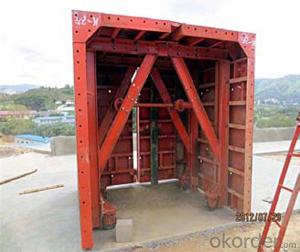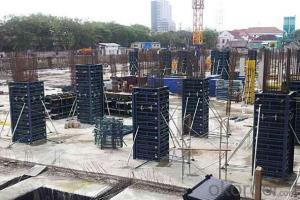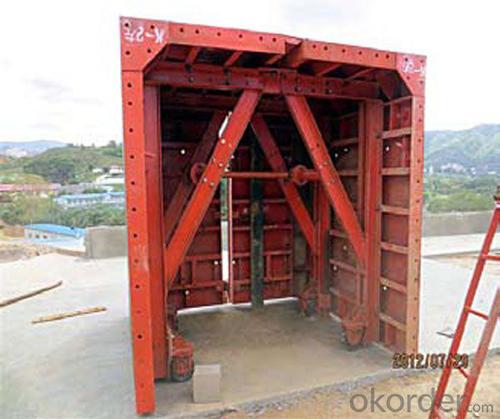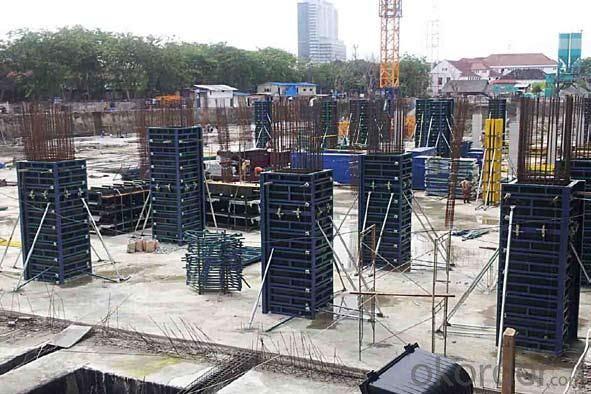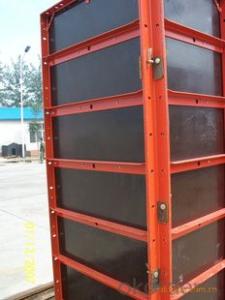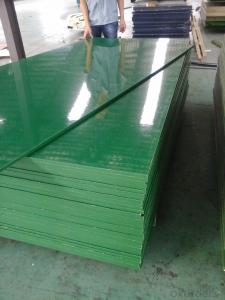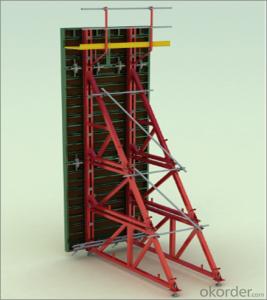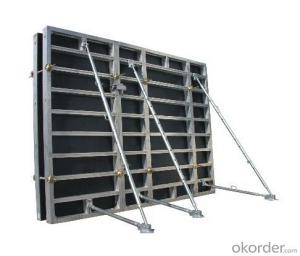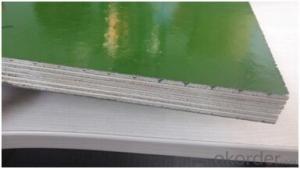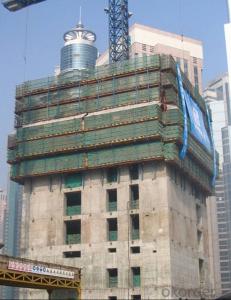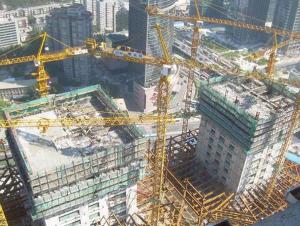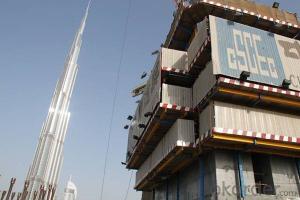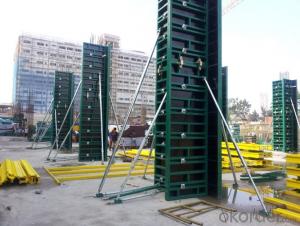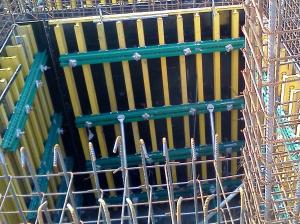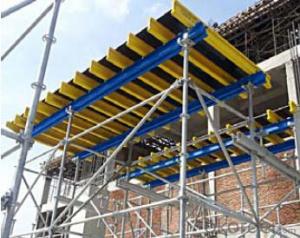Steel Formwork System Fromwork Accessories
- Loading Port:
- Tianjin
- Payment Terms:
- TT OR LC
- Min Order Qty:
- 3 m.t
- Supply Capability:
- 1000 m.t/month
OKorder Service Pledge
OKorder Financial Service
You Might Also Like
Steel Formwork System Fromwork Accessories
Product pictures:
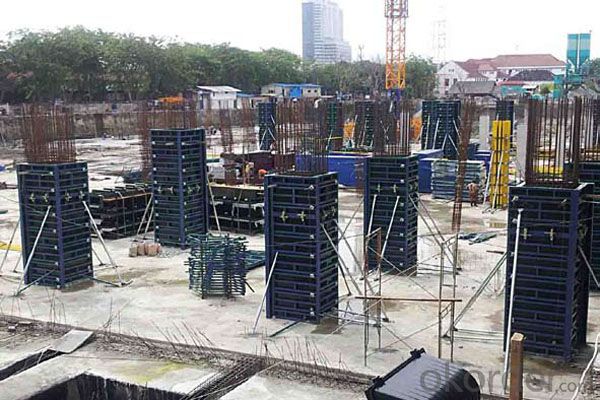

Product description:
Name: | RingLock Scaffold System |
Category: | Scaffolding System |
Material: | Steel (Q235/Q345) |
Size: | D48*3.25mm, etc |
Surface: | Electro Galvanized, Hot Dipped Galvanized, Painted, Powder Coated |
Component: | Standard, Ledger, Diagonal Brace, Bracket, Base Jack, U Head Jack, Etc. |
Application: | Slab Support, Staircase, Stage Plateforms, Bridge Support, Mobile Tower, etc. |
Manufacturer: | OEM is Available |
Items or goods can be manufactured according to your standards. | |
Advantage
* Good loading capacity
* Easy to assemble and dismantle
* Excellent quality for formwork & scaffolding with wide choices
Other scaffolding & formwork products:
(1) Scaffolding System:
(2) Scaffolding Frame & Accessories:
(3) Scaffolding Couplers/Clamps:
(4) Formwork System Scaffolding & Accessories:
Company introduce and advantages:
1. A state-owned company, prestige fi rst.
2. One of Fortune 500 companies in the world. No. 5 in the building material fi eld.
3. Six Sigma strategy , which means no more than 3.4 defects existing among one million of error
possibilities.
4. In line with the business, we launched E-business platform Okorder.com.
5. We are highly recognized by our business partners and clients all over the world and has obtained rapid
development under the spirit of win-win.
FAQ
Why Us?
We are one of the largest construction materials suppliers in China.
We own professional manufacturers with powerful producing capacity.
Extensive and comprehensive quality control system
Excellent products with competitive prices.
Efficient services in pre and after sale.
Full energy with affluent experience team.
- Q: How does steel frame formwork affect the overall cost efficiency of a project?
- There are multiple ways in which steel frame formwork can greatly enhance the cost efficiency of a project. To begin with, its durability and reusability eliminate the need for constant purchase or rental of formwork materials, thus lowering the overall formwork expenses for each project. Moreover, the flexibility of steel frame formwork allows for efficient construction of intricate structures by easily adapting to various shapes and sizes. This greatly reduces the time and labor required for formwork installation, resulting in cost savings. Another advantage of steel frame formwork is its ability to ensure impeccable quality control. By promoting accurate and precise construction, it minimizes errors and the need for rework, thus saving time and costs during the construction process. Additionally, steel frame formwork boasts exceptional resistance to wear and tear, offering a longer lifespan compared to traditional formwork materials. Consequently, it requires less maintenance and replacement, leading to long-term cost savings. Lastly, the quick assembly and disassembly process of steel frame formwork enable faster turnover times, thereby reducing the overall project duration. This results in cost savings through reduced labor and overhead expenses. In conclusion, the utilization of steel frame formwork can significantly improve the cost efficiency of a project by reducing material, labor, and maintenance expenses, enhancing construction speed, and ensuring top-notch construction quality.
- Q: What are the safety measures that need to be taken while using steel frame formwork?
- Some of the safety measures that need to be taken while using steel frame formwork include wearing appropriate personal protective equipment (PPE) such as safety helmets, gloves, and safety boots. It is important to ensure that the formwork is inspected regularly for any defects or damage before use. Workers should receive proper training on the correct assembly and dismantling procedures to prevent accidents. Adequate bracing and support should be provided to ensure stability and prevent collapse. Additionally, following proper handling techniques and using appropriate lifting equipment can help prevent injuries.
- Q: What are the key considerations for selecting the appropriate steel frame formwork rental company?
- When selecting the appropriate steel frame formwork rental company, there are several key considerations to keep in mind. Firstly, it is important to consider the company's reputation and experience in the industry. Look for a company that has a proven track record of providing reliable and high-quality steel frame formwork rentals. Reading customer reviews and testimonials can give you insight into their reputation. Secondly, consider the range of formwork options that the company offers. Look for a company that has a diverse inventory of steel frame formwork, including different sizes and types to suit your specific project needs. Additionally, it is crucial to assess the company's reliability and availability. Ensure that they have a sufficient quantity of formwork available when you need it and that they have a reliable delivery and pick-up system. Cost is another important consideration. Compare the rental rates of different companies to ensure that you are getting a fair and competitive price. However, be wary of extremely low prices as they may indicate poor-quality formwork. Finally, look for a company that provides excellent customer service. They should be responsive to your inquiries and provide clear and detailed information about their products and services. A reliable and helpful customer service team can make the rental process smoother and more efficient. By considering these key factors, you can select the appropriate steel frame formwork rental company that meets your project requirements and ensures a successful construction process.
- Q: How does steel frame formwork handle the placement of soundproofing and acoustical materials within the concrete structure?
- Steel frame formwork is a versatile and efficient method for constructing concrete structures, and it can handle the placement of soundproofing and acoustical materials within the concrete structure effectively. Soundproofing and acoustical materials are essential in minimizing the transmission of sound between different spaces or areas within a building. These materials are typically installed within the walls, floors, and ceilings of a structure to create a barrier against unwanted noise. When using steel frame formwork, the process of incorporating soundproofing and acoustical materials into the concrete structure can be easily accommodated. The formwork system provides a stable and secure framework that allows for precise and accurate placement of these materials during the pouring of concrete. Steel frame formwork can be customized to accommodate the specific requirements of soundproofing and acoustical materials. It can be designed with openings or recesses to accommodate the placement of these materials at the desired locations. These openings can be strategically placed to ensure optimal sound insulation throughout the structure. Additionally, steel frame formwork allows for easy installation and removal of formwork panels, which simplifies the process of installing soundproofing and acoustical materials. The panels can be easily adjusted or modified to accommodate the specific dimensions and shapes required for the materials. Furthermore, steel frame formwork provides excellent structural integrity and stability, ensuring that the soundproofing and acoustical materials are securely held in place during the pouring and curing of concrete. This prevents any displacement or damage to these materials, which could affect their effectiveness in reducing sound transmission. In conclusion, steel frame formwork is a suitable method for handling the placement of soundproofing and acoustical materials within a concrete structure. Its versatility, precision, and stability make it an ideal choice for incorporating these materials effectively, ensuring optimal sound insulation in the finished building.
- Q: How does steel frame formwork handle the placement of concrete in overhead structures or ceilings?
- Steel frame formwork is specifically designed to handle the placement of concrete in overhead structures or ceilings efficiently and safely. The steel frame provides the necessary support and stability to ensure that the formwork remains in place without any deformation or collapse during the pouring and curing process. Additionally, the steel frame formwork allows for easy removal after the concrete has set, leaving a smooth and finished surface.
- Q: What are the different types of concrete finishes that can be achieved with steel frame formwork?
- Steel frame formwork allows for the attainment of various concrete finishes. 1. The smooth finish is the most commonly achieved type. It involves ensuring the formwork is level and free of debris or imperfections, resulting in a smooth and even surface suitable for most applications. 2. The exposed aggregate finish is achieved by removing the top layer of concrete to reveal the aggregate beneath, such as stones or pebbles. This can be facilitated by incorporating removable top panels or utilizing specialized formwork systems. 3. The stamped finish involves using formwork with patterns or textures on its surface. By pressing the formwork into fresh concrete, a pattern or texture resembling stone, brick, or other materials is created. This finish enhances the aesthetic appeal of surfaces like driveways, walkways, and patios. 4. The polished finish is achieved by using formwork with a smooth and non-porous surface. After the concrete cures, it is polished using specialized equipment and diamond abrasive pads, resulting in a highly reflective and smooth surface commonly used in upscale residential and commercial applications. 5. The stained finish involves applying a chemical stain or dye to the concrete surface. Formwork can be designed to accommodate this finish by incorporating a release agent or utilizing specialized systems that facilitate easy application of the stain or dye. This finish adds color and visual interest to surfaces like floors, countertops, and walls. In conclusion, steel frame formwork offers versatility and flexibility in achieving different concrete finishes. By properly planning, preparing, and executing these finishes, the visual appeal and functionality of concrete structures can be enhanced.
- Q: When the steel frame tube structure adopts a rectangular plane, its aspect ratio should not be greater than the number of
- When the steel frame tube structure adopts rectangular plane, its length width ratio should not be greater than 1.5:1.
- Q: What are the different types of joints and connections used in steel frame formwork?
- There are several different types of joints and connections commonly used in steel frame formwork. These joints and connections play a crucial role in ensuring the stability and strength of the formwork system. 1. Wedge Connections: This is one of the most commonly used types of connections in steel frame formwork. It involves inserting a wedge into a slot to secure two components together. Wedge connections are quick and easy to assemble, making them efficient for construction projects. 2. Bolted Connections: Bolted connections involve using bolts and nuts to secure the formwork components together. This type of connection provides a high level of strength and rigidity, making it suitable for heavy-duty applications. Bolted connections also allow for easy disassembly and reassembly of the formwork system. 3. Pin Connections: Pin connections use pins or dowels to connect two components together. This type of connection is often used for aligning and joining formwork panels. Pin connections are quick to assemble and disassemble, making them ideal for temporary formwork systems. 4. Welded Connections: Welded connections involve fusing two components together using heat and pressure. This type of connection provides excellent strength and durability. Welded connections are commonly used in permanent formwork systems or where a high level of structural integrity is required. 5. Interlocking Connections: Interlocking connections use interlocking mechanisms, such as tabs and slots, to secure formwork components together. This type of connection provides ease of assembly and ensures a tight fit between the components. Interlocking connections are often used in modular formwork systems. 6. Clamped Connections: Clamped connections involve using clamps or brackets to secure two components together. This type of connection allows for easy adjustment and alignment of formwork components. Clamped connections are commonly used in adjustable formwork systems. It is essential to choose the appropriate type of joint and connection based on the specific requirements of the construction project. The selection should consider factors such as load-bearing capacity, ease of assembly, disassembly, and reusability. Proper installation and maintenance of the joints and connections are crucial to ensure the stability and safety of the steel frame formwork system.
- Q: How does steel frame formwork handle the placement of decorative elements and finishes within the concrete structure?
- Steel frame formwork is a versatile system that allows for precise placement of decorative elements and finishes within the concrete structure. The rigid and adjustable nature of the steel frame enables accurate positioning and alignment of the decorative elements during the pouring and curing process. This ensures that the desired design features, such as patterns, textures, and shapes, are seamlessly integrated into the final concrete structure. Additionally, the steel frame provides stability and support, allowing for the creation of intricate and complex decorative finishes.
- Q: Does steel frame formwork require any specific lifting or hoisting equipment?
- Yes, steel frame formwork typically requires specific lifting or hoisting equipment such as cranes or forklifts to safely lift and position the heavy steel frames into place.
Send your message to us
Steel Formwork System Fromwork Accessories
- Loading Port:
- Tianjin
- Payment Terms:
- TT OR LC
- Min Order Qty:
- 3 m.t
- Supply Capability:
- 1000 m.t/month
OKorder Service Pledge
OKorder Financial Service
Similar products
Hot products
Hot Searches
Related keywords
